AMD Teases Radeon RX 480: Launching June 29th For $199
by Ryan Smith on May 31, 2016 10:00 PM EST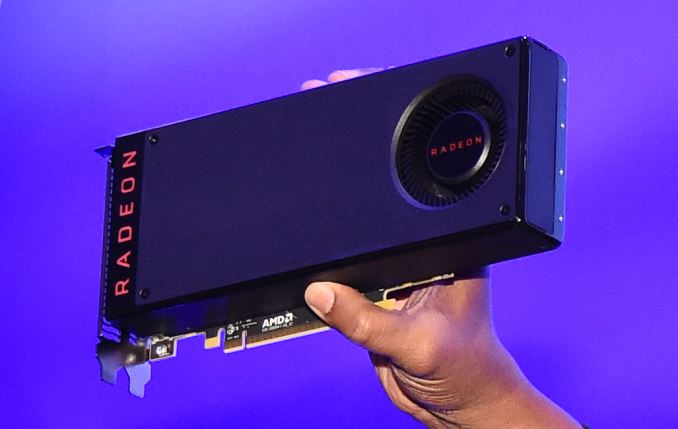
Kicking off at this moment is AMD’s Computex 2016 keynote. The company has multiple announcements scheduled this evening, but we’re going to jump right into an area that has been of extreme interest for many of our readers: GPUs.
Ahead of this evening’s event, AMD sent out an email to the press teasing the first of their discrete Polaris architecture based cards. Called the Radeon RX 480, AMD has unveiled much of the product’s specifications, but also its price and availability. When the card hits the streets on June 29th, it will be starting at the crucial mainstream battleground price point of $199.
| AMD Radeon GPU Specification Comparison | ||||||
| AMD Radeon RX 480 | AMD Radeon R9 390X | AMD Radeon R9 390 | AMD Radeon R9 380 | |||
| Stream Processors | 2304 (36 CUs) |
2816 (44 CUs) |
2560 (40 CUs) |
1792 (28 CUs) |
||
| Texture Units | (Many) | 176 | 160 | 112 | ||
| ROPs | (A Positive Integer) | 64 | 64 | 32 | ||
| TFLOPs (FMA) | >5 TFLOPs | 5.9 TFLOPs | 5.1 TFLOPs | 3.5 TFLOPs | ||
| Boost Clock | >1.08GHz | 1050MHz | 1000MHz | 970MHz | ||
| Memory Clock | 8Gbps GDDR5 | 5Gbps GDDR5 | 5Gbps GDDR5 | 5.5Gbps GDDR5 | ||
| Memory Bus Width | 256-bit | 512-bit | 512-bit | 256-bit | ||
| VRAM | 4GB/8GB | 8GB | 8GB | 2GB | ||
| Transistor Count | ? | 6.2B | 6.2B | 5.0B | ||
| Typical Board Power | 150W | 275W | 275W | 190W | ||
| Manufacturing Process | GloFo 14nm FinFET | TSMC 28nm | TSMC 28nm | TSMC 28nm | ||
| Architecture | GCN 4 | GCN 1.1 | GCN 1.1 | GCN 1.2 | ||
| GPU | Polaris 10? | Hawaii | Hawaii | Tonga | ||
| Launch Date | 06/29/16 | 06/18/15 | 06/18/15 | 06/18/15 | ||
| Launch Price | $199 | $429 | $329 | $199 | ||
First off, the RX 480 will include 36 CUs. If we assume 64 stream processors to a CU – the GCN standard – then this brings us to 2304 SPs. AMD has not named the specific Polaris GPU being used here, but given the CU count I believe it’s reasonable to assume that this is a Polaris 10 SKU, as I’ve already seen Polaris 11 and it’s a very small chip better suited for notebooks.
AMD also revealed that the card would offer over 5 TFLOPs of compute performance. Given what we know about the CU count, this allows us to estimate the GPU clockspeed. This puts the lower bound of the GPU clockspeed at 1.08GHz and an upper bound (6 TFLOPs) at 1.3GHz, which would be in the range of 10-30% higher clocked than comparable Radeon 300 series cards.
In terms of raw numbers this puts the RX 480 just shy of the current Radeon R9 390. However it also doesn’t take into account the fact that one of the major focuses for Polaris will be in improving architectural efficiency. I would certainly expect that even at the lower end of clockspeed estimates, RX 480 could pull ahead of the R9 390, in which case we’re looking at a part that would deliver performance between the R9 390 and R9 390X, with final clockspeeds and architectural efficiency settling just how close to R9 390X the new card gets.
On the memory front the card is equipped with 8Gbps GDDR5, running along a 256-bit memory bus. This is the typical bus width for AMD x80-series cards, and the high clocked 8Gbps GDDR5 means that we’re looking at a total of 256GB/sec of memory bandwidth to feed the RX 480’s GPU. AMD’s partners will be offering both 4GB and 8GB cards, and for the purposes of this teaser I assume that pricing information will be for the 4GB card, with 8GB serving as a premium option.
Finally, AMD has also revealed the TDP for the RX 480, stating that it will be a 150W card. As Polaris is built on 14nm FinFET, we’re seeing first-hand the benefits of finally making the long-awaited jump off of 28nm, as this means we’re looking at Radeon R9 390 series performance in a card that, on paper, consumes only a bit more than half the power. This also puts the RX 480 right in the sweet spot for mainstream cards, as 150W has traditionally struck a good balance between performance and power consumption that allows for a fast card that doesn’t require aggressive cooling, and is more compatible with OEM computer vendor case & cooling designs.
Cementing its place as a mainstream card, the RX 480 pricing will start at $199. This is an aggressive and heavily fought over price point that has traditionally defined the mainstream segment, attracting buyers who want great 1080p gaming performance that sub-$150 value cards can’t offer, without moving up to more expensive (and power hungry) $300+ cards. In this sense the RX 480 is a direct replacement for the R9 380, AMD’s Tonga-based card that hit the market roughly a year ago at the same price. Going by the raw numbers alone, RX 480 would be 40% (or more) faster than the R9 380.
Meanwhile I won’t speculate too much on the competitive market from a teaser, but it’s worth noting that this is nearly half the price of NVIDIA’s currently cheapest Pascal card, the GeForce GTX 1070. Interestingly both cards have the same 150W TDP, but looking at the throughput figures it does not look like RX 480 is meant to offer quite as high performance as NVIDIA’s card.
Moving on, along with teasing the RX 480’s specifications, AMD’s teaser also laid out their marketing plans for the card. We’re previously talked about how both Oculus and Valve/HTC were encouraging developers to treat VR like a fixed platform, and setting minimum hardware specifications to go along with that. On the AMD side those specifications called for a Radeon R9 290, which the RX 480 should be able to beat.
As a result AMD is planning on heavily promoting the VR aspects of the RX 480, as it brings the necessary performance down from a 250W, $300+ card to a 150W, $200 card. In fact AMD is claiming that VR performance will be closer to $500 video cards, in which case we’d be looking at performance closer to the Radeon R9 Nano, a Fiji based card.
With all of that said, the video card is just one component in the total price of a VR system – you still need the headset – but on the PC side it has also been the most expensive component. Consequently, AMD sees cheaper video cards that offer good VR performance as being important to bringing down the total price of a VR-ready system, and will be promoting the RX 480 as the prescription for entry-level VR needs. From a business perspective, AMD is ultimately expecting VR to be a fast-growing market, so the company wants to make sure they don’t miss out and have more VR-capable cards on the market as quickly as they can.
Along those lines, AMD’s release also makes note that at least one model will be “both HTC Vive Ready and Oculus Rift certified,” though no further details are being offered at this time. Whether this is just a certification matter or if there’s going to be something special about this model (e.g. connectors) is open to speculation.
Finally, now that they’ve revealed the price and much of the specifications of their first Polaris card, AMD is also releasing more details on their overall development and market positioning strategy with Polaris. As AMD has hinted at in the past, Polaris is being specifically developed for and aimed at the mainstream market. AMD wants to recapture lost market share – especially in laptops – and the large mainstream market is seen as the best way to do that. AMD is calling this their “water drop” strategy, and I expect we’ll hear a bit more about it tonight, including the meaning behind the name.
And with all of that said, it looks like we’re going to have a lot of AMD to talk about on June 29th. So until they, stay tuned.
Above: AMD SVP & Chief Architect Raja Koduri, Who Is Very Happy That Polaris Is About To Launch


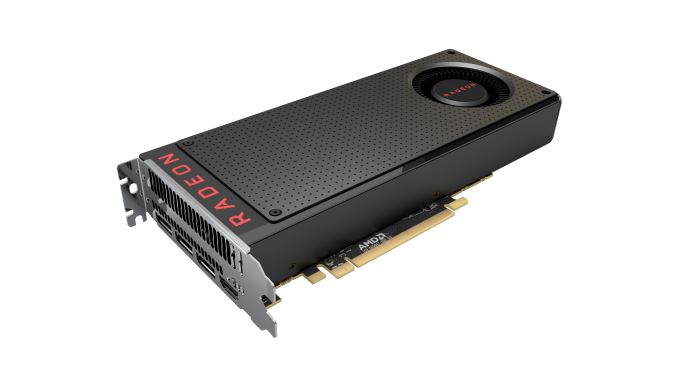

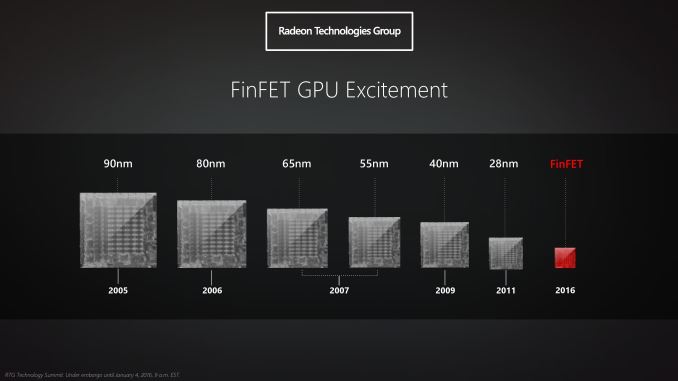
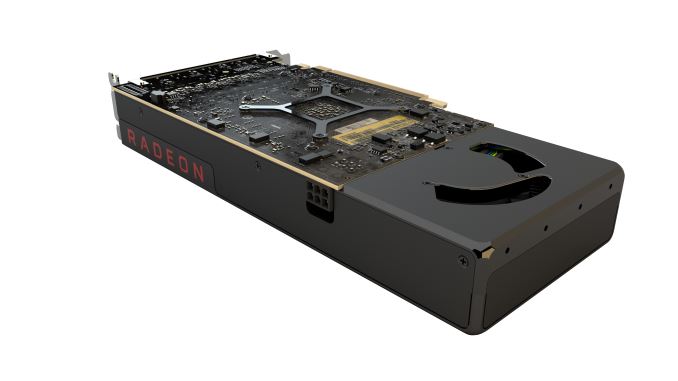




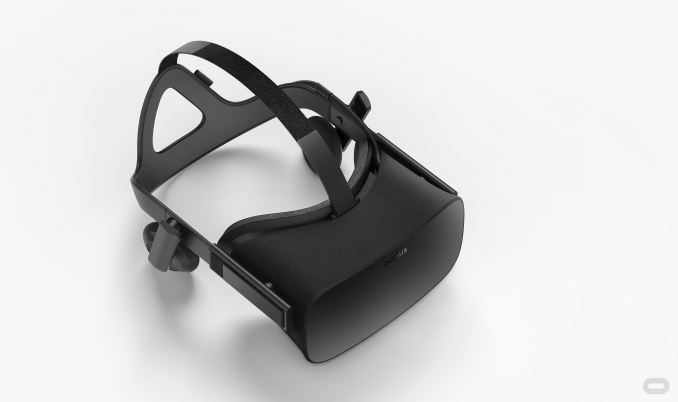









377 Comments
View All Comments
Meteor2 - Saturday, June 4, 2016 - link
Compute.Chaitanya - Friday, June 3, 2016 - link
In that last photo in gallery there seems to be connector of some sort visible on pcb anyone has idea what that is for?CountryBumkin - Friday, June 3, 2016 - link
Is this card supporting HDCP 2.2?I know it supports HDMI 2.0a
Thanks
JoeyJoJo123 - Friday, June 3, 2016 - link
Most likely yes.Regardless, any HDCP stripper will make the HDCP version support stuff a moot point.
versesuvius - Friday, June 3, 2016 - link
And with Polaris AMD has the narrowed the gap with NVidia from two years to one year, and with Zen the gap with Intel from 4 years to 3 years. That is progress and you can not knock it, but exactly how NVidia is going to react to this is already obvious. 1060 is going to be out around the middle of July with a TDP of 130 watts and a little better performance than 480X priced at $210. By the time Vega is out the door 1080Ti is already comfortably the fastest and highest performing GPU for the next year and a half. I was hoping against hope that AMD was going to actually announce Vega or at least give the specs for it but then again AMD lived up to its as of not so lately acquired reputation and just stayed behind both NVidia and Intel. Still, that is progress. Congratulations AMD. And congratulations to Intel and NVidia too. They won't have to worry about a visit by the antitrust commissioners for now.medi03 - Saturday, June 4, 2016 - link
Gap? What gap?Jesus, people.
980T loses to Fury X at resolutions starting from 1440p.
Comparing situation to CPU world, where Intel (STILL, even after bogus 14nm by Samsung) is years ahead process wise, is ridiculous.
Valantar - Saturday, June 4, 2016 - link
Sorry, but you're a bit off here. Sure, AMD has been a bit behind Nvidia the last generation - they lost bad on the failed 20nm process, while Nvidia (with their far larger resources) were able to pivot better. Then again, they're already close to closing the efficiency gap - within one generation! - while still competing on both price and performance. Also, I believe Nvidia got very, very lucky with the way Pascal clocks on 16nm, giving them better performance than expected - otherwise, they wouldn't be making a second-tier (soon to be third when 1080Ti rolls out) GPU that beats their previous flagship. We don't know anything about the clocks of GCN 4 yet, but it's probably not that high. Still, AMD can gain a lot of performance just from driver improvements, which they have been delivering steadily on for the last year. And value like the RX 480 is exactly where they need to deliver to stay relevant. Sure, flagships are image building, but they don't keep your company afloat.Also, there is no way the GTX 1060 is at 130W - the 1070 is 150W with 1920 cores at >1,7GHz. If clocks are equal, that would give the GTX 1060 ~1650 cores at 130W, which would neither be smart (it would cannibalize 1070 sales like crazy), or possible (the GTX 1080 has 4 GPCs (2560 CUDA cores), the 1070 has 3 (1920 cores), which would then put the 1060 at ... 2,5? That makes no sense when the 1060 is supposed to be based on a separate, smaller chip. Thus, 1280 cores (2 GPCs) is far more likely, as Nvidia designing a whole new GPC for "small Pascal" would be ludicrously expensive and economically inefficient (not to mention the nightmare of yet another level of driver optimization). And 1280 cores wouldn't need 130W unless they ran them at 2+GHz - which would be dumb in terms of both cooling, stability and warranty/RMA costs.
The GTX 1060 will in all likelyhood be around ~100W, and will probably perform similar to, if not slightly lower than, the RX 480. It will sell like hotcakes (it's going to be a midrange Nvidia GPU, after all), but AMD might have a winner here in terms of raw performance and price. We'll see.
Ananke - Monday, June 6, 2016 - link
I highly doubt NVidia will sell the 1060 for less than $279, which of course will be non-existent until the $350 "founders" edition is sold out...My point, don't expect anything "gaming" usable from NV for less than $300 this round.
SeanJ76 - Sunday, June 5, 2016 - link
More FAIL by AMD!!cocochanel - Monday, June 6, 2016 - link
What happens when one company brings a product that undercuts another company's profit margins ?The usual rant. And it usually comes from folks pretending to voice their own independent and unbiased opinion. In reality, and leaving the fanboys aside, these folks have a financial stake of some sort. And they don't like what they see.